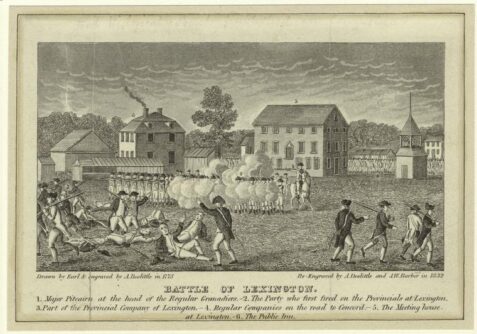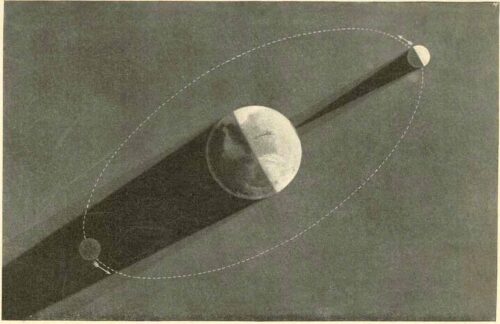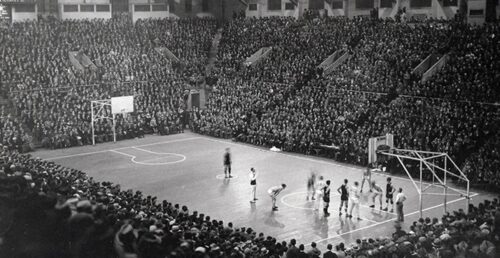Generosity, love of place, and local commitment: this is a recipe that can save America’s small towns and revitalize its places.
Where the Neon Lights Are Pretty
“How can you lose?” sang Petula Clark, about this welcoming place, beckoning to all, offering community and camaraderie. It had a pulse and vibrancy, with movie shows and even some “little places to go to.” The lights, she crooned, were “so much brighter there,” affording the lonely opportunity and enjoyment and escape. It was even therapeutic: You could “forget all your troubles, forget all your cares.”
All it took was a walk, a short drive, to Downtown.
As a young girl, Karen Buchwald Wright surely heard the massively popular hit that topped the charts and echoed through the years.
Little did she know it might be the anthem for her passion.
You May Find Somebody Kind
Herewith, the story of a determined woman who said: not in my town, not on my watch.
It begins at the intersection of happy memories and harsh present realities—of warm remembrances of a communal America with vibrant commerce bordering the public squares, where churches and libraries stood watch over war memorials and band grandstands on the village green, before the age of malls and man-caves and basement video gaming took root, and the current cold realities, harsh realities, of bypassed and left-behind and bedraggled squares, of abandoned factories and empty storefronts whose dusty lunch counters serve no soda and sell no local papers (because the newspaper was shut down a dozen years ago).
These are the all-too-familiar places populating—marring—the American landscape, the downtowns of small towns. Their aging, bygone memories remain vivid. Those memories arouse their occasional champions, be they public gadflies or Chamber of Commerce executives, who extol the virtues of new lampposts and brick sidewalks and economic development and all the panaceas they promise, but rarely deliver on.
But rare means real, means possible, means actual. And what happened—and what continues to happen—in one small Ohio city, and its lovely downtown, is quite real.
Industrialist, business leader, and philanthropist Karen Buchwald Wright’s remarkable passion and avalanche of charitable commitment to Mount Vernon, Ohio has saved it from a fate endured by many an American community, whose yesteryear vibrancy has given way to shuttered shops and weedy village greens.
The commitment started innocently enough: with a pool.
“I think one of my first projects was the Hiawatha Water Park Pool, probably 15 years ago, before the foundation,” she says, referring to the 2009 creation of the Ariel Foundation, the private charity endowed by the family-run and -owned Ariel Corporation. Based in Mount Vernon, and founded in 1966 by her father, engineering visionary James Buchwald, the incredibly successful Ariel Corporation has become the world's largest manufacturer of gas compressors.
“I read in the local paper that the Hiawatha Community Swimming Pool would have to close,” says Wright, “because it needed serious renovation and there wasn’t any money. I called the mayor and said, ‘let’s not close it. Let’s do the upgrade because there needs to be a community pool.’”
As for the money, she had it: The boostering came with a $500,000 contribution to bankroll the fix. “That started a great partnership with the mayor,” she says.
It got greater. Wright joined the board of the Knox County Foundation, with which the newly created Ariel Foundation “often partnered on local projects, particularly on Mount Vernon projects.”
Often? Are there any Mount Vernon projects Wright and the Ariel Foundation haven’t supported? A 2013 Columbus Dispatch profile of the local philanthropist said she “shovels millions of dollars into her hometown.” Seems like a payloader would be required to transfer the immense amount of generosity: Foundation executive director Jen Odenweller calculates that since 2009, “in excess of $70 million has been granted toward enhancing the quality of life in Mount Vernon through more than 500 grants to 80 local community partners.”
And that’s just the Ariel Foundation. A separate source of largesse comes from “Ariel Corporation’s philanthropic generosity,” says Odenweller, which includes “investments made in significant health- and education-focused community developments.”
What makes the cut? The non-sexy and municipal, for starters: Wright underwrites Mount Vernon’s costs for tree plantings and pruning, for snow removal and playgrounds (in particular, the fully inclusive Harmony Playground), the local Head Start, and even general support of the city schools. And there is the small and fun and whimsical, like the dog fountain at South Main Plaza, and a series of grand murals throughout the downtown.
Ahh, there is that word. What Wright is most proud of is “revitalizing the downtown by repurposing and renovating many buildings, and keeping the Victorian charm of the downtown intact.” Frequently on the road, it’s this collective sight that brings Wright contentment at the Mount Vernon homecoming. “Just seeing how vibrant and nice the downtown looks makes me happy.”
So does the bookstore, which is not a recipient of tax-sensitive philanthropy, but nevertheless the beneficiary of personal affection. Mount Vernon’s local bookstore was going the way of all local bookstores: oblivion. But, again, not on bookworm Karen Wright’s watch. She invested in the money-loser because the matter at hand had nothing to do with money-making. It had to do with the vibrancy of her community: “Every town needs a bookstore. It’s one of those things that makes the downtown complete” says Wright. “I love our little bookstore. It makes me, and lots of other people, happy.”
She also loves those things about which Joyce Kilmer gushed. “And I love the trees everywhere.”
Through the many trees her generosity has helped plant (thousands!) all over Mount Vernon, one can see the impact of Karen Wright’s revitalization crusade. It seems to know no boundaries, to consider no excess. For examples: The old Buckeye Candy and Tobacco Building has become, courtesy of Ariel Foundation millions, an annex for nearby Kenyon College, which uses it for classrooms, offices, and the Science Play-Space Initiative (which is dedicated to exposing children to science and technology). Another local college—Mount Vernon Nazarene University—has also been the beneficiary of Wright’s downtown revitalizing, with the main thoroughfare, South Main Street, now the home to the Buchwald Center, Hunter Hall, and the Stephen W. Nease Center, home to the school’s Department of Engineering.
All this is in the neighborhood of the Ariel Foundation-rehabilitated Hull Building (now the administrative home for Knox Community Hospital), a just-completed “loft-apartment project” providing numerous housing units (on the upper floors of renovated Victorian buildings on South Main Street) for college and hospital personnel, the Knox Memorial Theater, the historic Woodward Opera House, and the Grand Hotel.
Actually, it wasn’t always grand. It didn’t even exist until five years ago.
Out with the Inn
What reigned on the site, located smack dab on Mount Vernon’s town square, was the Curtis Inn. Its owners called it “historic.” Not the descriptor most people used for an establishment that arced decidedly toward seedy.
By coincidence, few travelers found it a destination. So came the debtors, and with bankruptcy, solid odds of abandonment and blight.
But Karen Wright fixed the odds. Hatching a plan with Nazarene University, she donated both the funds to buy the Curtis Inn at auction (the price tag was $430,000) and then underwrite its demolition and rebirth as something spanking new: a classy, boutique hotel—an appropriately named Grand Hotel—owned and operated by the college.
After all, says Wright, a great little city needs “a great place to stay so people can enjoy visiting Mount Vernon.”
There is another reason to visit this place. It’s but a 20-minute walk from the hotel. Not too long ago, however, it was a reason to stay away from Mount Vernon.
When Life Gives You Lemons
The famous preacher, Archbishop Fulton Sheen, is said to have coined the aphorism, a tonic against despair and for optimism, “Let the sour note become the first note of a new symphony.”
This spiritual guidance offers worldly inspiration too.
The people of Mount Vernon would need that. The sour note that made their small city of some 14,000 people wince came in the mid-1970s when Pittsburgh Plate Glass decided to close its massive plant. It was a significant blow to the community. With PPG’s departure went its many specialty jobs.
Not everything departed. Left behind on a 70-acre sprawl was a classic American manufacturing facility, worn and grim, smashed and buckling, boasting a cacophony of brick expanses and steel girders, of countless glass windows and towering smokestacks and outbuildings, of one million square feet of workspace that had provided generations with goodly wages and plentiful employment.
In a story too often repeated, giving this broad strip of America its “Rust Belt” sobriquet, the PPG plant shuttering was a case study in manufacturing hard times. And though the site remained home to a series of warehouses and other diminishing uses, time turned it derelict and blighted. As the millennium came, so did complete abandonment. The ghost was given up.
But not for some Mount Vernon citizens who had a far-fetched idea—or at least, an idea about an idea—about the enormous, in-your-face blight that they were determined not to let define their town.
As a series of ensuing legal actions dragged out over the fate of entangled property ownership, there emerged the outlines of a plan which saw in dilapidation an opportunity to repurpose the abandoned site—even to expand it—to create a unique public park. Whatever jagged path this vision would need to take, no one doubted this: If there were to be a restoration and rebirth of the PPG site, it would cost many millions of dollars.
Who, in Mount Vernon, had the loot?
The key player in converting this dream to reality—to take this rusting hulk and debris-strewn acreage and to regenerate it as a locus for communal benefit and enjoyment—was the quiet but engaged local philanthropist. Through the Ariel Foundation, Karen Wright provided the Foundation Park Conservancy—the eventual owners of the enlarged PPG property—major allotments of funds to design, remediate, expand, and create what is now known, because of the singular generosity she bestowed, as Ariel Foundation Park.
To date, Ariel Foundation—which continues to provide annual support for the Park’s staffing and upkeep—has granted $8 million to this exceptional project which has become a destination for travelers.
And it is exceptional. And visionary. The grim before—and stunning after images—of the once utter disrepair and present meticulous beauty—of the PPG site are pleasantly shocking. The thoughtfulness that went into salvaging and remaking the 225-acre public space is a testament of the community’s love for Mount Vernon, and of a testament of Karen Wright’s not-here determination to keep Mount Vernon from a fate borne by too many other American communities.
As it stands today, Ariel Foundation Park, which opened in 2015, pays homage to the molten and dangerous work of manufacturing plate glass that had thrived at this site—that had to some measure defined Mount Vernon—for seven decades. Much of what was remains on-site from its manufacturing past—rendered ugly and brute by the decades and dilapidation—has been turned into something collectively handsome and serene. A fascinating drone tour shows the thought, imagination, and care that went into preserving the site’s legacy, and the adaptive reuse of what—in too many similar situations, in too many American communities—would otherwise be a defining and festering scar.
Sitting alongside a series of boat-worthy, fishable small lakes and the Kokosing River, Ariel Foundation Park is festooned with reflecting pools, manicured terraces, pavilions, and trails, including a testimonial labyrinth that echoes the massive ribbons of glass once manufactured here (not to be outdone: a coral-blue, modern-artish “River of Glass”). The scene of numerous community events, such as July 4th concerts, the Park’s hallmarks are its observation tower (constructed in 1951, at 280 feet it is the tallest structure in Knox County) and its factory and foundry ruins—the brick walls and steel bones, still very much on display, are strangely beautiful, and a series with old buildings, spared from the fate of utter demolition—remain, bringing a Stonehenge feel and sense of permanence to central Ohio, posing as stark obelisks that quietly honor the time when the Park grounds glowed with industrial might.
Be It Ever So Humble
The list of things on the receiving end of Karen Wright’s charity (per the Dispatch: “I feel like it is not an obligation but something I should . . . that I want to do”) may not be inexhaustible, but it comes close. In addition to major support for a slew of yet-unmentioned projects, including the Kokosing Gap Trail, the major capital renovation of the Mount Vernon YMCA, and The Winter Sanctuary, providing emergency shelter and self-sufficiency help for local homeless, it is the new Wright Family Medical Pavilion at Knox Community Hospital that brings her particular pleasure.
Who can blame her? After all, “It has a state-of-the-art birthing center where my most recent granddaughter was born.”
It’s hard to top that as a reason for joy, but the fact that the Center provides the community much-needed bed space, and a facility for offering special medical services, comes close.
It had been the case that Karen Wright’s ill neighbors would have to drive hours to Columbus or Cleveland for specialized care.
But not anymore. All that is now found at this new and sparkling and welcoming place Karen Wright rightly calls “a wonderful facility.”
If you’re looking for directions, it’s only a short five-minute drive from. . .
Downtown.
No maybe about it: Mount Vernon is small as cities go. But thanks to Karen Wright, it is where a generous person of means, looking for inspiration, will find one of the most outstanding demonstrations of all that can be accomplished by heartfelt philanthropy that is committed to the local, zealous about the native, and passionate about that place where charity begins, and has always begun: home.
Before Your Leave . . .
At the kick-off conference for the Center for Civil Society—it will take place on November 17th in Scottsdale, Arizona, and its theme is “Restoring American Community”—attendees (givers, doers, and thinkers with a love of place and charity) will be able to hear from Karen Wright and other philanthropists who have made it their passion to strengthen civil society with a profound home-sweet-home focus, as well as young leaders (who are optimistic about America!), wise folks who are adept at providing consequential help to veterans, and some big brains who speak passionately and convincingly about the virtues of voluntary associations (indeed, they are so important to defining American exceptionalism) and the differences between “philanthropy” and “charity.” It’s going to be a great day, a great undertaking, one that will impact attendees. Consider attending. You’ll find more information, and a means of registering, right here.







2 thoughts on “Charity begins at home: The amazing love that would not abandon a small city and its downtown”